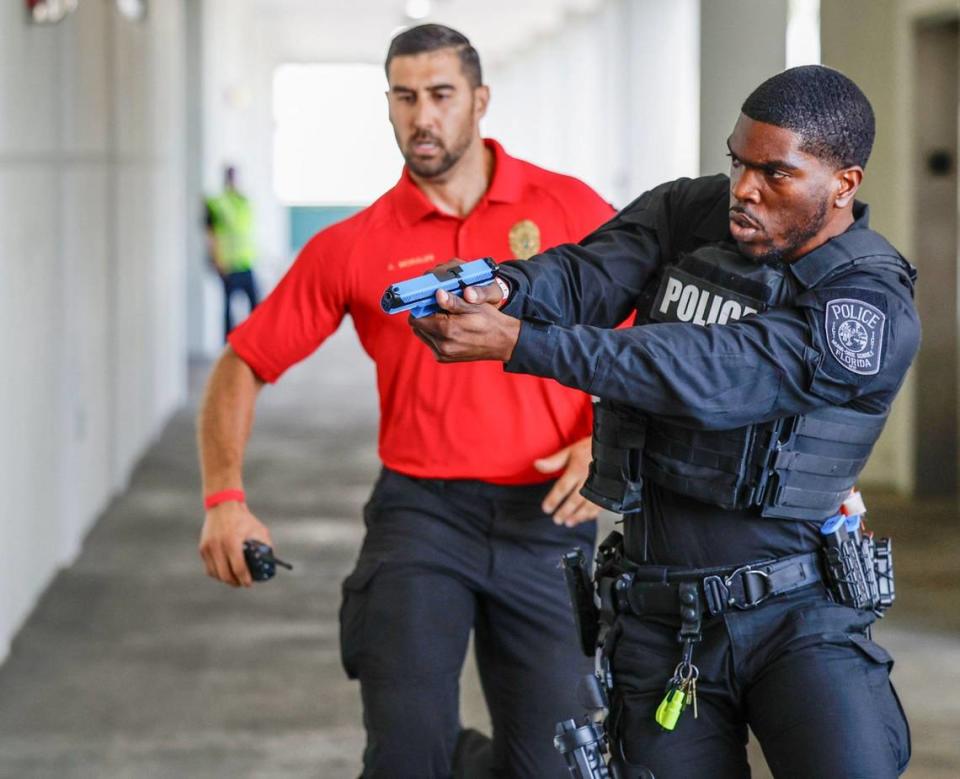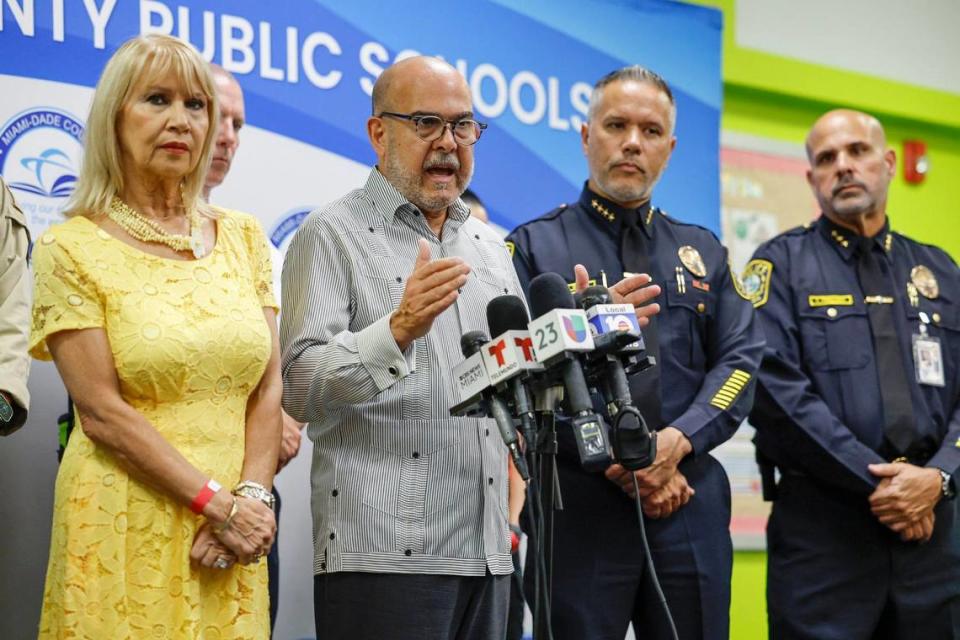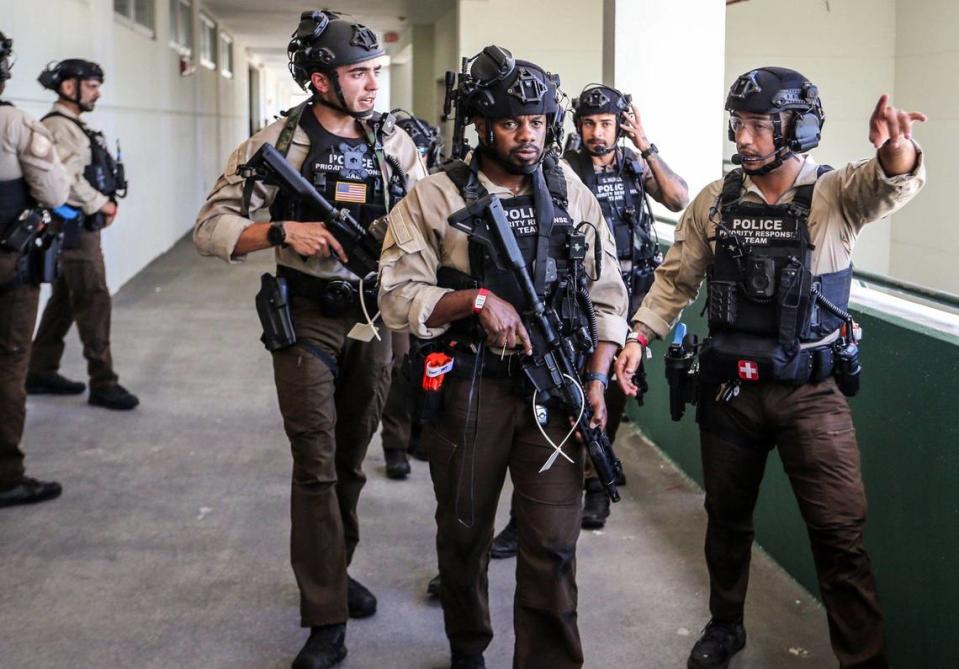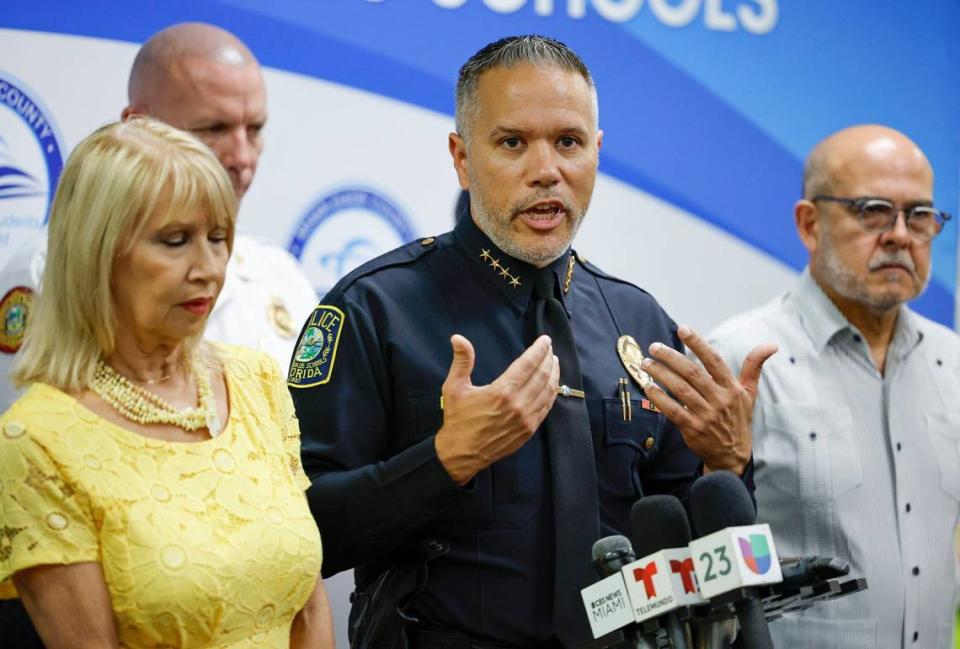Miami Central Senior High seemed more like a police training camp than a high school on Thursday morning as Miami-Dade school police officers patted down and searched the bags of people as they entered the cafeteria.
Members of the school band quietly played their trumpets inside as students on the dance team rehearsed and officers from several law enforcement departments prepared to work together for a large-scale active shooter drill, a practice that has become both common and controversial. While district officials and law enforcement tout these school safety efforts, there is growing evidence that these drills are not effective.
The cafeteria, which was the staging area for the drill, was filled with participants, including students, staff and officers from the the Miami-Dade Schools Police, the City of Miami Police Department, the Miami-Dade County Police Department, the North Miami Police Department, and even U.S. Customs and Border Patrol.
“Everybody ready to go, you got your wounds?” said an officer as he poked his head into the school cafeteria. Students, many of them football players, were having fake wounds applied and getting splattered with artificial blood to make the simulation seem more realistic.
In minutes, more than fifty armed officers, including members of the Miami-Dade priority response team – decked out with helmets, bulletproof vests, and large guns would begin the simulation.
Three loud gunshots marked the beginning of the drill.
Through a radio positioned on an officer’s duty belt, you could hear a dispatcher notify the officers of the fake active shooting: “Gunshots are being fired,” they said.
Soon after, screams came from a classroom on the upper story of the building. On the ground level, patrol cars pulled up to the front of the building, sirens blasting – and dozens of officers spilled out of their cars running into the school. The school fire alarm blared.
Zulimar Zamora, an incoming sophomore had fake gun wounds on each leg and sat on the cement among other students pretending to squeal in pain. “Help, my leg!” she said, as officers jogged past, searching for the fake shooter.
A police officer posing as a school shooter ran across classrooms and hallways.
At one point in the drill, one officer advised the other: “Make sure you maintain a 360-degree vigilance.”

Within minutes, the fake shooter was located in a classroom and shot dead by officers.
The apparently wounded students were then attended to and carried away by officers.
The final step in the plan is to reunify students with their parents, at a location that will be determined based on the circumstances of the emergency.
Debate over effectiveness of large-scale drills and armed officers
Miami-Dade School District Superintendent Jose Dotres was at the drill Thursday and touted the district’s efforts regarding school safety. But some experts believe that large-scale drills that aim to simulate a real life situation can do more harm than good.

These kinds of drills can often traumatize participants, says Scott Woitaszewski, professor and chair of the Department of Counseling & School Psychology at the University of Wisconsin-River Falls. He is also chair of the School Safety and Crisis Response Committee, a national committee that advises schools on how best to respond to security threats.
He says that although sensorial drills such as the one at Miami Central High School may seem valuable, they are not recommended by research and can even be harmful to students and teachers.

“Students who have experienced trauma in a variety of ways, especially gun violence, for them to be involved in a highly sensorial armed assailant drill at school could be a very negative thing for them. It can re-traumatize them,” he said.
Nationally, there have been examples of teachers and students saying they were traumatized by the drill.
A report on armed assailant drills in schools endorsed by the The National Association of School Psychologists and the National Association of School Resource Officers suggests that lockdown drills that don’t involve simulations are best practice. The report also says that drills that mimic a real experience can be traumatizing.
But chief of the Miami-Dade schools police, Ivan Silva, says these drills are helpful because during times of stress, officers revert to their training.
Woitaszewski says the question of whether to have an armed officer on school campuses is complicated. On one hand, it can create an increased sense of safety for some students. But he also pointed to examples where having an armed resource officer did not prevent the shooting. He also added that some student feel less safe having an armed officer on campus, especially students of color coming from communities where trust of law enforcement is low.
“I think it just needs to be very carefully thought through and not just assumed that having law enforcement, especially armed officers on site, is going to somehow make things safer,” he said.
A large-scale study from 2021 written by two criminal justice and law enforcement professors in St. Paul Minnesota analyzed over 130 school shootings between 1980 and 2019 and found that having armed guards did not show a significant reduction in rates of injuries. According to the researchers, the rate of deaths was 2.83 times greater in schools with an armed guard present.
A 2013 study from the FBI found the majority of shootings ended within 5 minutes or less, and therefore it is often difficult for armed guards to be useful in the most important moments.
Some civil rights activists believe that having armed guards on school campuses can pose a risk to students throughout the school year. The Advancement Project, a civil rights organization that advocates for people of color, created a map of incidents where school police officers perpetuated violence against students. Recently in Miami-Dade a school police officer was accused of body slamming a 14-year-old.
The Miami-Dade school police department has one armed officer in every school in the district, although Ivan Silva, the chief of police for the Miami-Dade schools police department, was unsure whether the specific school resource officer for Miami Central High was present at this year’s drill.
‘Learning from our past incidents’
The first priority in this kind of scenario is always to stop the killing, said Silva. The second priority is to “stop the dying, which basically is to treat the wounded immediately.”
The Miami-Dade Schools Police Department’s school resource officers are trained to immediately respond to an active shooter and to shoot if needed, instead of waiting for other authorities to arrive.
“That’s the difference between learning from our past incidents to what we do today,” said Silva.

During the school shooting at Marjory Stoneman Douglas High School in Parkland which killed 17 people and wounded 17, an armed school police officer did not go inside the high school or try to engage the gunman during the attack. After the shooting, he was suspended without pay, then immediately resigned and retired.
After Thursday’s drill, the chief of police for Miami-Dade Schools Police said that teachers and students should fight back if absolutely necessary. But, “don’t engage if you don’t have to,” said Silva.
He also said all teachers have a mobile app on their phones with a button that can be pressed to notify 911 and the school resource officer in case of an emergency.
School safety is a top priority for many of the Miami-Dade school board members. It is also a top priority for some of the candidates for the school board’s upcoming election.
School districts across the country continue to work to find ways to increase safety in schools.
In Broward County, metal detectors will be installed in 10 schools during the upcoming school year.
Miami-Dade County has contracted with an advanced mapping technology company that will created digitized maps across all of its 573 schools. The maps aim to help first responders understand the layout of a school in cases of emergency; they are slated to be completed in time for the upcoming school year beginning on Aug. 15.
Miami Herald intern Alecia Taylor contributed to this report.
EMEA Tribune is not involved in this news article, it is taken from our partners and or from the News Agencies. Copyright and Credit go to the News Agencies, email news@emeatribune.com Follow our WhatsApp verified Channel





